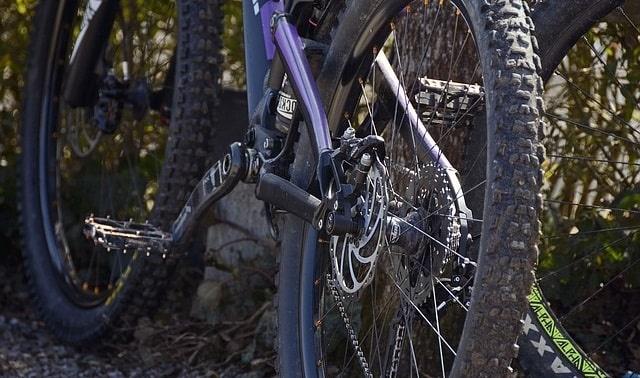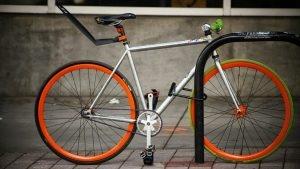In terms of bike pedals, there are two mainstream types of pedals, Flats(also known as platform) and clipless. Today I’ll primarily be covering Flats and the two main materials used in them.
Often people are looking for cheap, easy, and effective upgrades for their bikes. Pedals are a great option as they’re one of the more affordable options, really simple to install, and can greatly affect your riding. Two of the more common types/materials of pedals are aluminum (or otherwise known as alloy) and composite (otherwise known as nylon).

There is a large debate on whether one is better than the other and they definitely both have their benefits and drawbacks but it’s largely due to personal preference. I’ll be going over the differences between them and their pros and cons to help you figure out which ones best fit your needs to give you the ultimate riding experience.
What’s the difference?
Composite pedals are made of a softer material, generally cheaper, and slightly less durable.
Aluminum pedals are made of metal and are slightly more expensive. They will also be slightly heavier which in turn equates to them being more rigid and therefore can be thinner while still providing just as much support. Composite pedals will be slightly thicker and therefore more likely to have a pedal strike.
However on the occasion that you do strike your pedal on a rock or the ground then it is commonly said that composite helps absorb the vibrations and be less jarring than aluminum. Thinner pedals also slightly lower your center of mass and make you feel more connected to your bike because your feet are closer to the point of rotation.
This isn’t a very large difference but every small detail counts. With the materials that composite are made from there is also consistent coloring throughout the interior so even if you shave some off by striking your pedal then the color will remain the same unlike the outer layer of anodization on aluminum that will be shaved off and leave you with the greyish color of metal in places.
So if the aesthetic is your main priority, then composite will keep its color. It also has more of a matte finish than aluminum and the colors they come in are more vibrant whereas the colors of aluminum are generally darker and glossier however you can also find some more unique colors like oil slick with aluminum pedals.
Most cheap bikes come with a pair of crappy plastic pedals and more expensive bikes often don’t include pedals due to the fact that everybody has a different preference, but if they do then it’s generally a cheaper pair of mediocre composite pedals.
 Another thing to keep in mind is how much they hurt when you bash them into your shin, because if you ride singletrack then you probably know the experience and if not then you’re either lying or extremely lucky because I promise you it will happen and you won’t enjoy it. With that in mind, composite will hurt a lot less bashing into your shin than aluminum.
Another thing to keep in mind is how much they hurt when you bash them into your shin, because if you ride singletrack then you probably know the experience and if not then you’re either lying or extremely lucky because I promise you it will happen and you won’t enjoy it. With that in mind, composite will hurt a lot less bashing into your shin than aluminum.
Durability
One of the most important aspects of bike pedals is their durability. You want to ensure that what you’re standing on while bombing down hills and flying off jumps is stable and trustworthy.
Composite pedals are a type of plastic while aluminum is metal so obviously, aluminum will be more durable and withstand more abuse than composite. Aluminum is more likely to flex under a lot of pressure where composite would crack or snap.
With that being said it doesn’t mean composite pedals are bad, people have been riding them for a long time now and they withstand abuse pretty well. In the past composite pedals used to be pretty garbage but they’ve advanced to the point now that they’re completely viable as long as you buy from a reputable company and not some cheap website from china that sells knockoff parts.
You don’t need to worry about your pedals breaking in the middle of a ride. You will have to replace composite pedals more often due to them being less strong and wear down easier but they’re also cheaper so it’s up to you whether you want to buy a more expensive pair of aluminum that will last you a long time or a cheaper pair of composite that you’ll have to replace more often.
Grip
Grip is very important when riding. You don’t want to be constantly slipping off your pedals especially on jumps as that could be very catastrophic!
Aluminum pedals will almost always grip better than composite just because composite is a lot slippier material than aluminum, especially in the rain or when your shoes are wet.
However, lots of higher-end pedals have interchangeable studs/pins/screws that you can put into your pedal. These are what actually dig into the sole of your shoe and provide grip so changing these can greatly affect the grip of your pedals. They’ll also affect the amount of pain when you bash it into your shin depending on the type of studs/pins/screws that you put in.
Pros of composite
- Lighter
- Cheaper
- Keeps color after pedal strikes
Cons of composite
- Thicker
- Less durable
- Less Grippy
Pros of aluminum
- Sturdier
- Thinner
- Grippier
Cons of aluminum
- More expensive
- Loses outside layer of color after pedal strikes
- Heavier
Conclusion
There’s no solid answer that one is better than the other. They are both great options that won’t be holding you back. It comes down more to personal preference. Some people swear by aluminum while others swear by composite.
If you are an extremely aggressive rider without a budget and want maximum performance then aluminum would be the way to go. On the contrary, if you just want a cheap pair of pedals to cruise around occasionally then you’ll be quite satisfied with composite.
It’s really up to you to determine which you prefer but I hope this article gave you better insight into which pedal might better suit you best on your next purchase.

Hi, my name is Noah Dalton. I am an avid, young rider from Canada that loves mountain biking primarily Enduro and Downhill.
“I don’t ride a bike to add days to my life, I ride a bike to add life to my days!”


